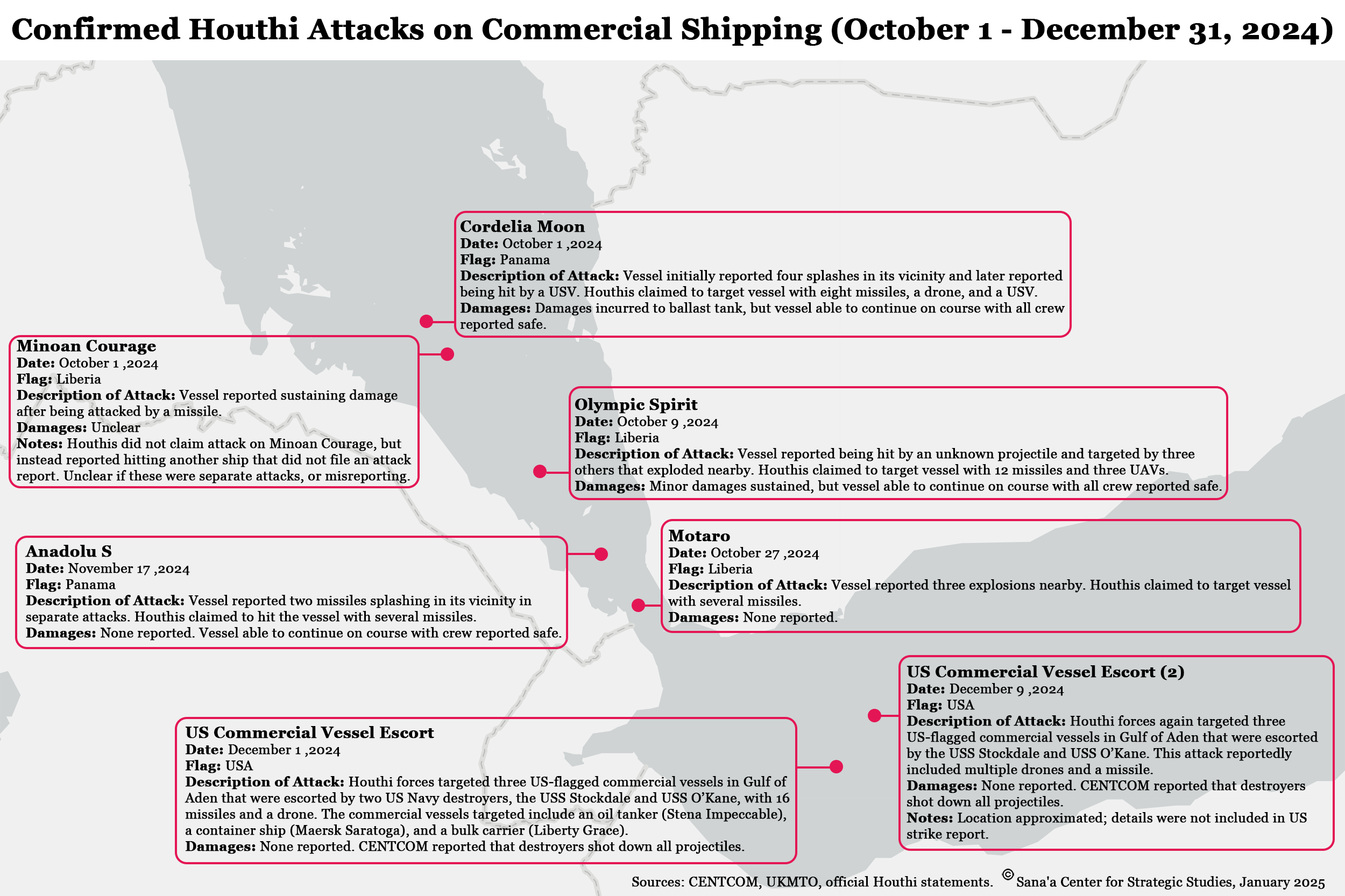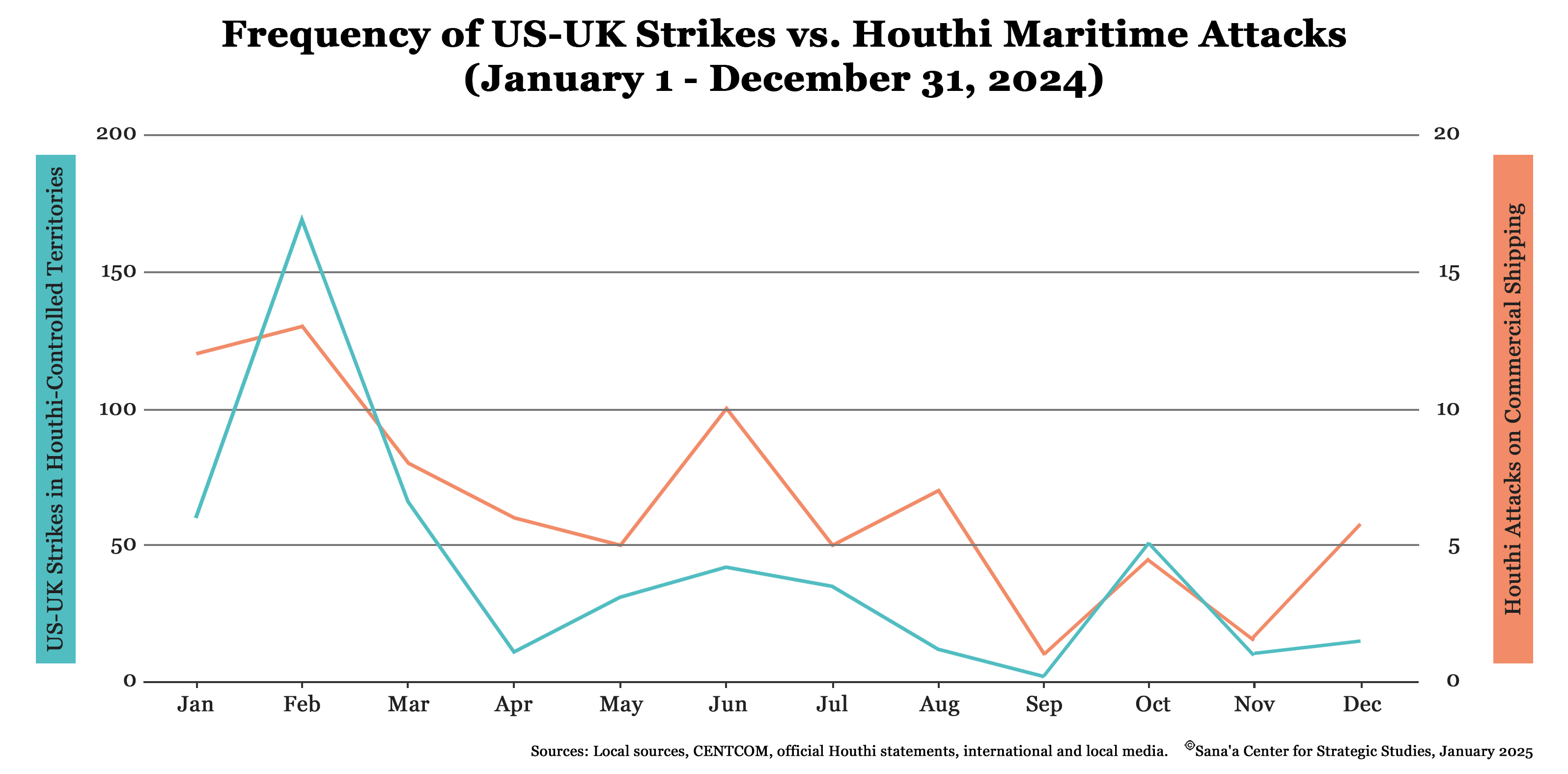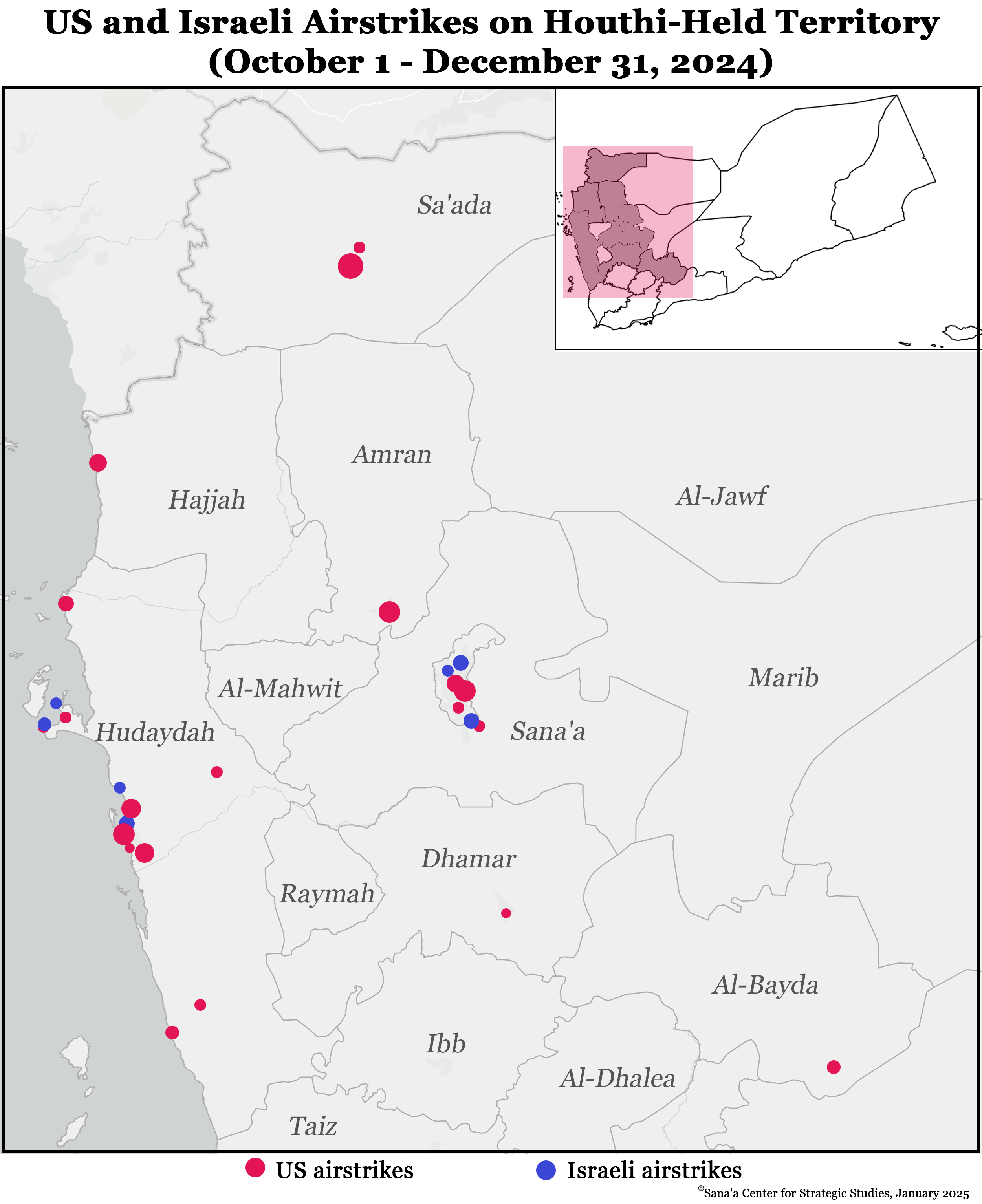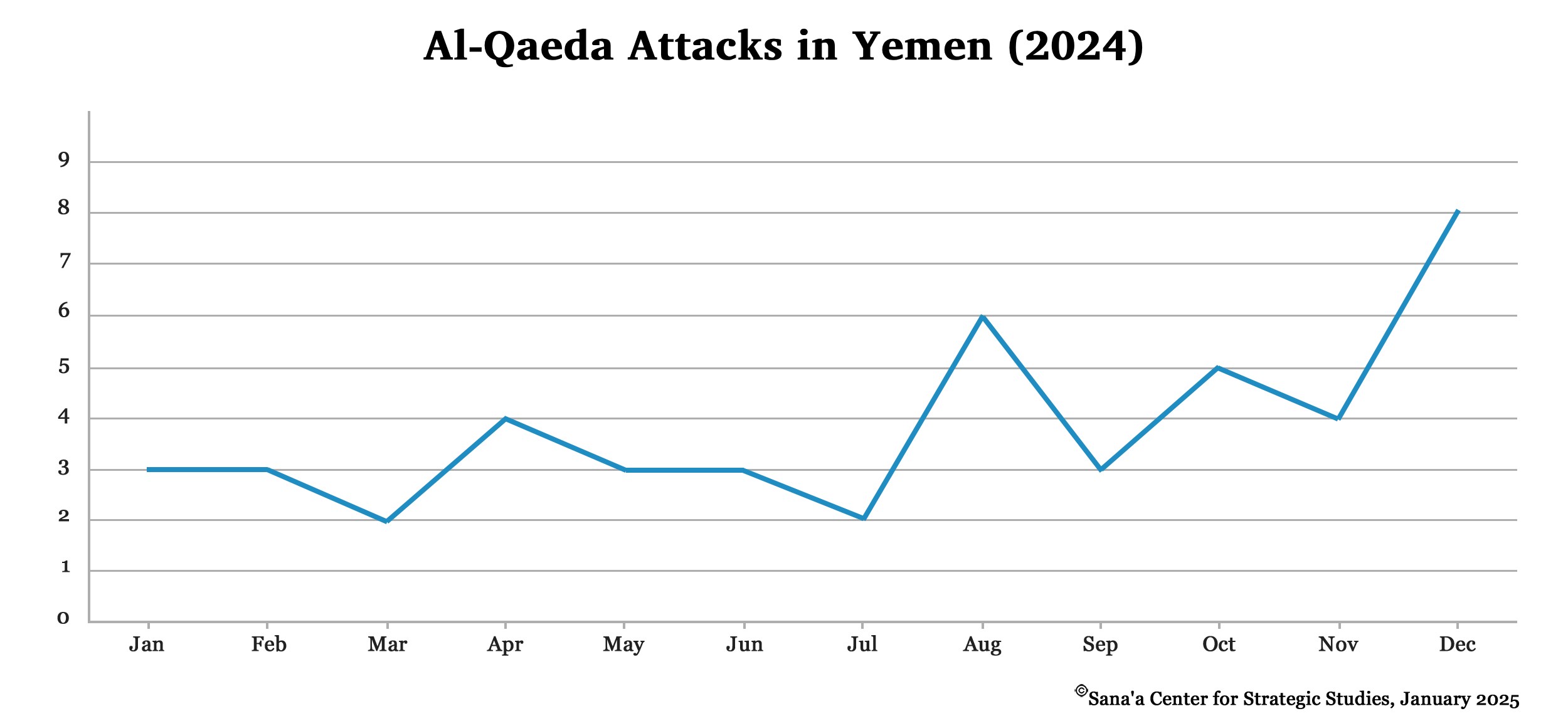Bases Over Boats: Houthis Shift Missile Strategy
The final months of 2024 – bookended by the assassination of Lebanese Hezbollah leader Hassan Nasrallah in late September and the announcement of a Gaza ceasefire in January 2025 – were undoubtedly a period of redefinition for Houthi military leadership, as the group once again shifted its strategy in targeting Israel, the United States, and their strategic interests in the Red Sea. While Houthi missile and drone barrages continued throughout the quarter, attacks shifted away from commercial shipping to focus instead on military bases and infrastructure within Israel itself.
The decision to target Israel is not new – the Houthis made headlines in July after a drone crashed into a residential apartment near the US Embassy in Tel Aviv. Since then, the group has launched numerous projectiles, particularly in coordination with Iran-backed Iraqi militias, targeting southern Israel with relatively little success. A rise in such strikes against Israel this quarter indicates that this has become the preferred mode of attack, in a shift from a strategy that had prioritized targeting commercial shipping.
Houthi forces claimed to directly target Israeli territory on at least 24 occasions in the past three months, compared to only seven confirmed attacks on commercial shipping in the same period. Of these, nearly two-thirds occurred in December alone, as the group attempted to increase pressure to advance a ceasefire deal.
Targets of the attacks included a variety of buildings in the Tel Aviv-Jaffa metropolitan area, as well as the southern port town of Eilat and the city of Ashkelon. Along with numerous UAVs, dozens of Palestine 2 and Zulfiqar missiles targeted Israeli military bases and energy infrastructure, as well as the Ben Gurion International Airport and the Israeli Defense Ministry headquarters in Tel Aviv.
The vast majority of these attacks were thwarted by Israeli air defense systems – a reminder that the Houthi arsenal, while it has “shocked” experts with its rapid development and sophistication in recent months, is still limited in its capacity to inflict significant damage against Israel. This is largely because Houthi attacks have been isolated in nature – often, no more than three or four projectiles were fired at a given target. This makes them easily detectable for an air defense system designed to simultaneously down hundreds of projectiles.
But that is not to say that the Houthi threat to Israeli territory is not legitimate. Israeli military officials have repeatedly complained of the difficulty of deterring such attacks, which have kept warning systems on high alert. A number of projectiles have bypassed Israeli defenses in recent months, inflicting damages to residential areas and causing minor casualties. Projectiles struck a private residence on December 9 and a school building on December 19, while a fuselage from a downed missile damaged a home on December 16. On December 21, a missile purportedly targeting a military site wounded at least 14 people. While the Houthis attributed these “successes” to jamming software and evasion techniques, Israeli forces often chalked them down to human error.
The focus on Israeli land interests has meant that Yemen’s sea lanes are the quietest they have been since the Houthis began targeting ships in November 2023. Of the seven confirmed Houthi attacks on commercial shipping, nearly all occurred in the weeks following Nasrallah’s death; only one attack was verified in November and two in December (both of which were convoys of American-flagged vessels escorted by US warships). The Houthis increasingly took aim at US military vessels, alleging multiple hits on both the USS Abraham Lincoln and USS Harry S. Truman aircraft carriers – claims which the Pentagon categorically denied. On one instance, Houthi spokesman Yahya Sarea even claimed credit for the downing of two US Navy pilots over the Red Sea on December 22, which the Pentagon reported was due to a friendly fire incident. Both men survived after ejecting from their F/A-18 aircraft, one with minor injuries.
US and Israeli responses to Houthi attacks remained relatively unchanged, though Israeli retaliatory strikes have kept pace with the surge in Houthi projectiles. As in previous months, Israeli strikes targeted energy stations, infrastructure, and ports, drawing sharp criticism for their proximity to civilian areas. For their part, US forces continued to target Houthi weapons storage facilities, which they claimed were used to target US military and commercial ships. Notably, the US Central Command (CENTCOM) diverged from its typically detailed reporting of targets destroyed, choosing instead to report only major developments and strikes (a trend that seems likely to continue under the Trump administration). Among more routine strikes, operations included the use of B-2 stealth bombers to target underground facilities for the first time in Yemen on October 16 and the launching of Tomahawk missiles from US destroyers on December 31.
Hadrami Groups Recruit New Troops, Restructure Units
Multiple security sources have reported that the Saudi-trained Nation’s Shield forces, formed in 2023 and put under the direct control of PLC chief Rashad al-Alimi, have received significant funding from Riyadh to draw in Salafi recruits in recent months. To this end, the group has reportedly established major bases for military training and Salafi indoctrination in Hadramawt and Al-Dhalea. Reports also suggest that Saudi officials have prompted the PLC to recruit Salafis in Al-Mahra as part of a special “Al-Mahra Shield” unit of the Nation’s Shield. Saudi forces stationed at Al-Ghaydah Airport are reportedly overseeing this recruitment and have already received funding to establish a training center.
Unlike other groups in Yemen, the Nation’s Shield is paid directly and in cash, meaning they are not subject to the long salary delays that afflict other government-affiliated units. Saudi funds are supplemented by revenues the group extracts from the Al-Wadea border crossing with Saudi Arabia, which it took over in August. The promise of regular salary disbursement amid deteriorating economic conditions, along with its ideological appeal, have contributed to the group’s rapid growth in the past two years, allowing it to compete with more well-established groups like the Security Belt forces and the Giants Brigades – two UAE-funded groups from which the Nation’s Shield has been aggressively recruiting Salafi fighters.
The Shield’s October expansion, taking over military checkpoints and watchtowers along the Al-Abr road, which connects Hadramawt with Shabwa, led to concerns and rumors that the group could also be eying the PetroMasila oil fields or the Al-Dhabba oil terminal in Hadramawt. Feathers were ruffled not only in the Southern Transitional Council (STC), which has been calling for the more extensive deployment of the UAE-backed Hadrami Elites in the governorate, but also among the leadership of the Seyoun-based Islah-affiliated 1st Military Region, which previously controlled the Al-Abr road. Such tensions reflect the delicate nature of military politics in Hadramawt – a balancing act that was on full display in December after Al-Alimi’s appointment of new commanders to lead the 1st Military Region. Saleh al-Juaimilani replaced Saleh Taimas as the top commander, and Ali Yahya al-Adbai replaced Yahya Abu Awaja, the region’s de facto head, as commander of the Seyoun-based 135th Infantry Brigade, regarded as one of the most powerful in the Yemeni army.
Not wanting to be left out, the Hadramawt Tribal Alliance (HTA) announced the formation of a new militia in December, the Hadramawt Protection Forces, which will reportedly operate outside the state’s military command and control structure. The HTA, led by Hadramawt deputy governor Amr bin Habrish, has been challenging Governor Mabkhout bin Madi’s authority since the summer. Time will tell if the Protection Forces take any real responsibility in the governorate or, like numerous Hadrami groups before them, succumb to the fray of partisan politics. Regardless, the PLC’s promise to matriculate thousands of Hadramis into the government armed forces and security units will likely ensure that competition in the eastern governorate will not resolve anytime soon.
Frontlines Remain Active
Uncertainty over the Houthis’ shifting role in the Axis of Resistance sparked a flurry of military buildups and redeployments in late October that saw massive numbers of troops flock to Hudaydah. A Houthi-affiliated security source in Al-Jawf reported that the group withdrew from nearly 70 percent of security and military sites across the governorate in anticipation of the supposed renewal of hostilities in Hudaydah. Redeployments, which in Al-Jawf included strategically important areas and border regions with neighboring governorates, also occurred in Al-Bayda and Ibb. According to local sources, Houthi- and government-aligned forces mobilized an “unprecedented number” of troops to key frontlines in coastal Al-Tuhayta district and areas surrounding Hays district to the east. Troop numbers nearly doubled in these areas, and Houthi forces reportedly brought in rocket batteries, heavy artillery, and guided missiles.
Areas to the north and west of Taiz city were particularly active this quarter as well, as Tareq Saleh’s National Resistance forces and the Islah-affiliated Taiz Military Axis worked to fight off Houthi incursions. In particular, the Al-Kadha front and its affiliated Barah Axis to the west of Taiz city in Al-Maafer district have seen a steady increase in fighting. Saleh’s forces reported dozens of Houthi casualties there in at least seven battles between October and November. In late December, an unidentified truck carrying two vehicles equipped with missiles was observed in the Barah area, sparking fears that the Houthis could be mobilizing forces to target frontlines in neighboring districts.
Troop buildups have also continued in Al-Dhalea and Lahj, where fighting is now an almost daily occurrence. In mid-December, significant Houthi military reinforcements in the form of soldiers, equipment, and salaries arrived at the Bab Ghalaq, Murais, and Al-Fakher fronts, where Ahmed al-Marani, a commander from Sa’ada governorate, has been called on to lead the mobilization efforts.
Al-Qaeda Attacks Increase
As with previous months, Al-Qaeda operatives presented a constant threat in Abyan’s Omayran Valley and Shabwa’s Al-Saeed district, where the group has planted landmines and launched attacked against STC-affiliated and UAE-backed groups. A spike in operations since late October has rekindled old questions about how the group may try to reposition itself in Yemen as regional dynamics shift.
Other Developments in Brief
October 22: Houthi forces carried out Operation “Sadden Your Faces,” in coastal areas of Hudaydah, which included four military exercises, including naval, desert, mountain, and urban warfare maneuvers. Major naval exercises were also conducted on November 23 in the Ibn Abbas Sea off the southern coast of Al-Munira district and Al-Luhiyah district.
October 24: Iran and Saudi Arabia held joint naval exercises in the Sea of Oman, a major step forward for the two rivals with regional tensions escalating and maritime safety becoming a key concern. Reuters earlier reported that Iran had also conducted exercises with Russia and Oman, with Saudi Arabia as an observer.
October 30: The Wall Street Journal reported that a Russian warship evacuated Islamic Revolutionary Guard Corps (IRGC) commander Abdul Reza Shahlai from the port of Hudaydah in April. Shahlai was recently identified by a UN Panel of Experts report as the “Jihad Assistant” of the Houthi Jihad Council, effectively one of the most senior positions in the Houthi military system. Shahlai, who allegedly directed a failed plot to assassinate the Saudi ambassador to the US in 2011, reportedly arrived in Yemen later that year to build up Houthi military capabilities.[1]
November 3: A Ukrainian journalist reported that the Russian-flagged bulk carrier Zafar was making a second trip to the Houthi-controlled port of Al-Salif in Hudaydah to deliver wheat from Sevastopol in Russian-occupied Crimea. The vessel reportedly received approval from the UN Verification and Inspection Mechanism for Yemen (UNVIM) in Djibouti, where it was located at the time of reporting. A similar shipment was made in July, as reported in a joint investigation by Bellingcat and Lloyd’s List, raising concerns about the potential transfer of Russian arms to Yemen.
November 24: The Financial Times reported that since July, Russia has recruited hundreds of Yemenis for its war in Ukraine, in a further sign of growing ties with the Houthi movement over the past year. The report said the men, traveling via Oman, were dragooned into the Russian army after being lured by promises of well-paid work that would lead to Russian citizenship. The main recruiter cited in the piece, Abdulwali Abdo Hassan al-Jabri, is a well-known General People’s Congress (GPC) figure from Taiz who has been ostracized by its Sana’a-based branch for his close alignment with the Houthis in recent years.
- While the WSJ did not provide the specific dates of the alleged evacuation, the Sana’a Center recorded the arrival of the Russian frigate Marshal Shaposhnikov to the Eritrean port of Massawa on March 28, accompanied by a cruiser, the Varyag, on a surprise mission in which Eritrea was not announced as a destination. The Shaposhnikov stayed at Massawa for more than a week.





